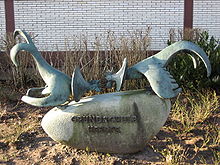Hesepe (Bramsche)
|
Hesepe
Bramsche parish
Coordinates: 52 ° 26 ′ 26 " N , 7 ° 57 ′ 51" E
|
|
|---|---|
| Height : | 45 m |
| Residents : | 2560 (May 27 1970) |
| Incorporation : | July 1, 1972 |
| Postal code : | 49565 |
Hesepe is a district of the town of Bramsche in the district of Osnabrück in Lower Saxony .
Only after the Second World War did the far-flung peasantry become a dense settlement. Hesepe is located directly on the B 68 and B 218 as well as a train station on the Oldenburg – Osnabrück and Delmenhorst – Hesepe railway lines , which meet here. The RB 58 (Osnabrück – Bremen) and irregular individual trains of the RE 18 (Osnabrück – Wilhelmshaven) stop regularly at Hesepe station. During the Second World War, there was a large military airfield in Hesepe. Dutch armed forces were stationed in Hesepe until the end of the 1980s . After their departure, the area, which was no longer used by the military, served as a border transit camp for ethnic German repatriates . It later functions as a state reception center for Jewish contingent refugees and repatriates. From 2003, the facility came to the Central Admission and Immigration Office in Oldenburg, now accommodating asylum seekers whose applications had already been legally rejected in order to organize their departure. Since May 2014, the Bramsche facility of the Lower Saxony State Reception Authority has been the third initial reception facility for asylum seekers after Braunschweig and Friedland .
history
origin of the name
The name Hesepe includes two stems from old age. In Osnabrück there is a Hesepe on the Hase around 1169 as Hesbe , the village of Hespe near Stadthagen is also called Hesepe in 1284. The basic word epe , old form apa , can be found all over Germany, mostly in the Sauerland , and describes a small watercourse everywhere. It is believed in the Sanskrit Ambhas (water), lat. Amnis , old ambnis , as well as the Greek. Ombros , lat. Imber ( rain ) and also the Celtic-Irish depend find for river, so in short, an Indo Urstammwort.
The determinant has or häs (always long spoken: Häsepe ) is more difficult to interpret . For Hesepe, the old form Hasba (probably more correct Hasapa ) cannot be derived from the Hase river, since then there would be a duplication that is foreign to the old place name. Has and Haas are often found in place names without allowing a uniform conclusion. The most likely thing to think of is the meaning has = dark, fog, which also goes well with the water of the hare.
War crimes 1945
After the American bombing of Hesepe airfield on March 24, 1945, one of the 300 attacking B-17 bombers "Flying Fortress" was brought down by an anti-aircraft gun. Three of the crew members were killed in the crash and six were able to parachute in time. Sgt. Paul Berger landed with his parachute near the alternative motor vehicle camp in Thiene and was then taken prisoner. The soldiers who were supposed to take him to the air base in Hesepe shot him on the way there. The perpetrators, the staff director Alfred Büttner and the civil employee Otto Franke were sentenced to death in the subsequent war crimes trial, which took place on December 23, 1945 in Osnabrück . The executioner Albert Pierrepoint executed them on March 8, 1946 in the Hameln penitentiary .
Military facilities
Willem-Versteegh-Kamp
The Willem-Versteegh-Kamp was occupied by Dutch units on July 1, 1964. Use was finally given up on July 29, 1988. The stationed units were distributed to other bases in Germany and the Netherlands. In December 1988 the barracks became the Hesepe border transit camp, which today bears the name of the State Reception Authority (LAB).
Corps depot
On the northern part of the former airfield, the Bundeswehr set up a depot for the I. Corps in the 1960s . The KorpsDp 156 Hesepe was abandoned after a few years and cleared.
Incorporation
On July 1, 1972, Hesepe was incorporated into the city of Bramsche.
Population development
Resident population of the municipality of Hesepe with territorial status as of May 27, 1970:
| date | Residents |
|---|---|
| May 17, 1939 | 1069 |
| September 13, 1950 | 1861 |
| June 6, 1961 | 2348 |
| May 27, 1970 | 2560 |
Individual evidence
- ^ Lower Saxony State Reception Authority
- ↑ Executioner atoned for the murder of US soldiers. In: noz.de. Neue Osnabrücker Zeitung , April 3, 2010, accessed on May 4, 2020 .
- ^ The Hameln prison in the post-war period. In: http://www.gelderblom-hameln.de/index.php . Retrieved May 4, 2020 .
- ^ The gates of Willem-Versteegh-Kamp will be officially closed on July 29th . In: Bramscher Nachrichten . July 14, 1988.
- ^ Federal Statistical Office (ed.): Historical municipality directory for the Federal Republic of Germany. Name, border and key number changes in municipalities, counties and administrative districts from May 27, 1970 to December 31, 1982 . W. Kohlhammer GmbH, Stuttgart and Mainz 1983, ISBN 3-17-003263-1 , p. 254 .
- ↑ Lower Saxony State Administration Office (Ed.): Municipal Statistics Lower Saxony 1970. Part 2: Population and Employment, Volume 5: District Osnabrück, Hanover 1973, p. 40.
